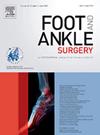慢性踝关节不稳的治疗和预防:荟萃分析综述。
IF 1.9
3区 医学
Q2 ORTHOPEDICS
引用次数: 0
摘要
背景:慢性踝关节不稳定(CAI)是一种常见的高致残性疾病。尽管已有多项研究对 CAI 的预防和治疗策略进行了评估和分析,但仍需要对证据进行公正、系统的综合,以便为 CAI 的预防和治疗提供最有力、最全面的循证措施。本研究旨在综合现有文献中有关 CAI 治疗和预防的证据:方法:系统检索了 PubMed、Embase、Cochrane 和 Web of Science 数据库中从开始到 2023 年 12 月 12 日的相关研究。提取了选定干预措施的效应大小和相应的 95 % 置信区间数据。使用测量工具(即 "AMSTAR 2")对纳入研究的质量进行系统性回顾评估:共纳入 37 项研究,其中 21 项(57%)为高质量或中等质量。强有力的证据表明,较低的体重(P 结论:这是第一项综合了 "AMSTAR 2 "的研究:这是第一份综合了支持治疗和预防 CAI 干预措施的证据的研究。低体重和体重指数是预防 CAI 的有效措施。运动、手法治疗、针灸和手术可改善 CAI 患者的踝关节功能。足底感觉治疗和神经肌肉训练可能是CAI患者的良好治疗选择:证据等级:一级。本文章由计算机程序翻译,如有差异,请以英文原文为准。
Treatment and prevention of chronic ankle instability: An umbrella review of meta-analyses
Background
Chronic ankle instability (CAI) is a common and highly disabling condition. Although several studies have evaluated and analyzed prevention and treatment strategies for CAI, an unbiased and systematic synthesis of evidence is required to provide the most powerful and comprehensive evidence-based measures for the its prevention and treatment of CAI. This study aimed to synthesize evidence from the existing literature addressing the treatment and prevention of CAI.
Methods
The PubMed, Embase, Cochrane, and Web of Science databases were systematically searched for relevant studies from inception to December 12, 2023. Data on effect sizes and corresponding 95 % confidence intervals for selected intervention measures were extracted. Systematic reviews were assessed for quality of included studies using a measurement tool (i.e., “AMSTAR 2”).
Results
In total, 37 studies were included, among which 21 (57 %) were of high or moderate quality. Strong evidence suggested that lower weight (P < 0.001), lower body mass index (P = 0.002), and non-stability defects (P = 0.04) significantly reduced the risk of developing CAI. Strong evidence supported exercise and moderate evidence supported manual therapy, acupuncture, and surgery for improving CAI. Additionally, external support plays an active role in the treatment process of CAI.
Conclusion
This is the first study synthesizing evidence supporting interventions for the treatment and prevention of CAI. Low body weight and body mass index were effective preventive measures against CAI. Exercise, manual therapy, acupuncture, and surgery can improve ankle function in patients with CAI. Plantar sensory treatment and neuromuscular training may be good therapeutic options for patients with CAI.
Level of evidence
Level I
求助全文
通过发布文献求助,成功后即可免费获取论文全文。
去求助
来源期刊

Foot and Ankle Surgery
ORTHOPEDICS-
CiteScore
4.60
自引率
16.00%
发文量
202
期刊介绍:
Foot and Ankle Surgery is essential reading for everyone interested in the foot and ankle and its disorders. The approach is broad and includes all aspects of the subject from basic science to clinical management. Problems of both children and adults are included, as is trauma and chronic disease. Foot and Ankle Surgery is the official journal of European Foot and Ankle Society.
The aims of this journal are to promote the art and science of ankle and foot surgery, to publish peer-reviewed research articles, to provide regular reviews by acknowledged experts on common problems, and to provide a forum for discussion with letters to the Editors. Reviews of books are also published. Papers are invited for possible publication in Foot and Ankle Surgery on the understanding that the material has not been published elsewhere or accepted for publication in another journal and does not infringe prior copyright.
 求助内容:
求助内容: 应助结果提醒方式:
应助结果提醒方式:


